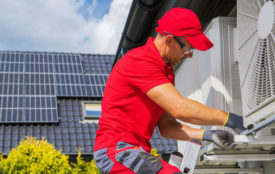As many rooftops as possible: Recommendations for an ambitious EU-wide solar mandate
The EU should phase in the solar mandate as swiftly as possible – from the end of 2024 – for as many building types as possible, as well as for car parks. In addition, all member states should be required to create favourable domestic conditions so that the potential to generate solar energy on suitable rooftops can be utilised to the full.
Alternatives to the EU proposals
These are just some of the recommendations made by an Oeko-Institut research team in a Policy Brief on behalf of the Climate Action Network (CAN) Europe. The aim is to identify ways to boost the effectiveness of the European Commission’s current proposals. The Commission is planning to introduce a rooftop solar mandate across the EU as part of the revision of the Energy Performance of Buildings Directive (EPBD).
Rapid and phased introduction of the solar mandate
The researchers recommend introducing the solar mandate on 31 December 2024 – two years earlier than the Commission’s proposed start date (31 December 2026). After entry into force of the Directive at EU level in mid-2023, the member states would then have 18 months to transpose the Directive’s provisions into national law.
A phased introduction based on building type would facilitate the mandate’s early start. In parallel to the stepwise rollout of the mandate, training could be provided for fitters and an infrastructure developed for materials in order to avoid skills shortages and spikes in the solar industry.
Integrating more surfaces
The requirement to install solar equipment would apply immediately from the end of 2024 to all buildings of any type undergoing extensive roof renovations, as well as to all newbuilds. According to the Oeko-Institut’s team of experts, it should also apply to new car parks. The EU’s legislative proposal does not currently include provisions on solar installation as part of roof renovations.
Furthermore, as the Policy Brief notes, the mandate for unrenovated buildings should cover not only commercial and public buildings, as proposed by the Commission, but commercially operated residential buildings as well. This obligation should be introduced progressively, based on the size of the rooftop area, and would only apply to roofs with a residual expected lifespan of at least 20 years. For existing residential buildings in private ownership, the member states should incentivise the installation of rooftop solar equipment. In addition, a European solar rooftop register would enable property owners to make their roofs available for installation of photovoltaic systems by third parties.
Recommendations on solar thermal, funding, formalities
Solar thermal installations should also qualify as systems which fulfil the requirements of the European solar mandate. However, as these systems generally only occupy a small proportion of the rooftop’s surface area, they would have to be combined with a PV system in order to comply with the solar mandate. The member states should establish funding programmes, including specific schemes for low-income households: the mandate should apply to these households as well so that they are able to participate in the energy transition. A contact point (one-stop-shop) should be established to keep red tape to a minimum, provide all the necessary information and assist with the formalities. To allow follow-up, specific indicators should be used for regular reporting by member states on the progress of the solar rollout.








